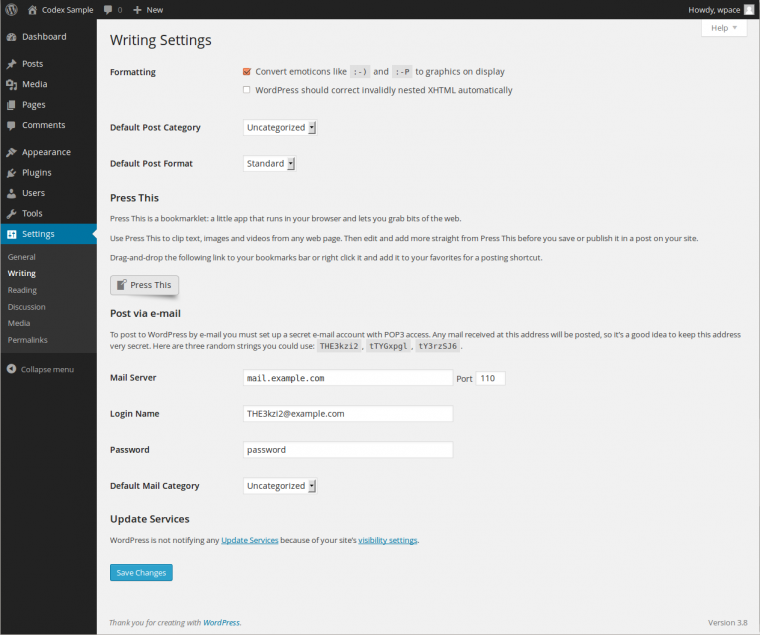Interested in functions, hooks, classes, or methods? Check out the new WordPress Code Reference!
Settings Writing Screen
Languages: English • Writing SubPanel 日本語 Português do Brasil • (Add your language)
Contents
Settings → Writing
Use the Settings Writing Screen to control the interface you use when writing new posts. These settings control WordPress's features in the adding and editing posts, Pages, and Post Types, as well as the optional functions like Remote Publishing, Post via e-mail, and Update Services.
Back to Administration Screens.
Writing Settings
- Formatting
- You can use these checkboxes to control some of your blog's formatting.
- Convert emoticons such as :-) and :-P to graphics on display - Checking this tells WordPress to convert all of the emoticons in your posts into graphical smilies. For more information on this feature, see Using Smilies.
- WordPress should correct invalidly nested XHTML automatically - Checking this helps make sure that what you write in your posts is valid XHTML code. You should probably check this box since invalid code sometimes causes problems with web browsers. Note: some Plugins may not work correctly when this feature is turned on.
- Default Post Category
- The Category you select from this drop-down is called the default post Category. The default post Category is Category assigned to a post if you fail to assign any other Categories with writing your posts. If you delete a Category, the posts in that Category will be assigned the default post Category. If you have several Categories, but use one of those Categories more frequently, select that Category here to make your life a little easier.
- Default Post Format
- The Post Format you select from this drop-down is called the default Post Format. Post Formats are used by themes to create different styling for different types of posts. This settings is only visible if the current activated theme supports Post Formats. The WordPress Twenty Seventeen theme is an example of a theme that supports various Post Formats including Standard (no special format), Aside, and Gallery.
Press This
- Press This is a bookmarklet: a little app that runs in your browser and lets you grab bits of the web.
- Use Press This to clip text, images and videos from any web page. Then edit and add more straight from Press This before you save or publish it in a post on your site.
- Drag-and-drop the following link to your bookmarks bar or right click it and add it to your favorites for a posting shortcut.
Post via e-mail
- With this option, you can set up your blog to publish e-mails as blog posts. To do this, you would send an e-mail to a specific address you've established for the purpose. More than likely, you will need the help of your web host and/or your e-mail provider. This feature is 100% optional; you can still publish posts from the Posts Add New Screen if you don't want to post via e-mail. The Blog by Email article describes this feature in greater detail.
- This messages is displayed at the beginning of this section: "To post to WordPress by e-mail you must set up a secret e-mail account with POP3 access. Any mail received at this address will be posted, so it’s a good idea to keep this address very secret. Here are three random strings you could use: FKZXx8EK, P6snQ5Lq, YcrfBw03."
- Complete the following fields to post by e-mail:
- Mail Server
- A mail server receives e-mails on your behalf and stores them for retrieval. Your mail server will have a URI address, such as mail.example.com, which you should enter here.
- Port
- Servers usually use port 110 to receive requests related to emails. If your mail server uses a different port, enter that port number here.
- Login Name
- If, for example, the e-mail address that you will be using for the writing by e-mail feature is wordpress@example.com, then 'wordpress' is the Login name.
- Password
- Enter the password for the above e-mail address here. Three possible passwords are displayed by WordPress in the introduction section of this Screen.
- Default Mail Category
- WordPress will assign this Category to all of the posts published via the Post by e-mail feature. Note: You can create new Categories in Administration > Posts > Categories.
Update Services
- When you publish a new post, WordPress automatically notifies the update services of the sites listed in the box. For more about this, see Update Services on the Codex. When entering services, separate multiple URIs with line breaks. If your Privacy Settings Blog Visibility is set to "I would like to block search engines, but allow normal visitors", the message "WordPress is not notifying any Update Services because of your blog's privacy settings" is displayed.
Save Changes
- Click the Save Changes button to ensure any changes you have made to your Settings are saved to your database. Once you click the button, a confirmation text box will appear at the top of the page telling you your settings have been saved.
